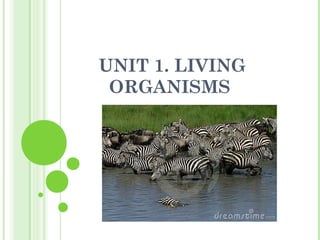
Unit 1 Living organisms
- 2. WHAT TO LEARN Chemical composition of living organisms. The vital functions The structure of cells The type of cells The cell theory
- 3. WHAT ARE LIVING THINGS? Organisms with a similar chemical composition, perform three vital functions and are made of cells. CHEMICAL COMPOSITION INORGANIC COMPOUNDS ORGANIC COMPOUNDS SIMPLE MOLECULES Ex: Water and minerals COMPLEX MOLECULES Ex: Sugar, lipids, proteins, nucleic acids.
- 4. THE THREE VITAL FUNCTIONS NUTRITION INTERACTION REPRODUCTION Take substances from the environment Perceive changes in the environment called stimuli and react to them Produce descendents
- 5. WHAT IS A CELL? All living things are made of cells. It’s the basic unit of life and it can perform the three vital functions.
- 6. Types of living things UNICELLULAR ORGANISMS MULTICELLULAR ORGANISMS ONE CELL Ex: Bacteria MANY CELLS Ex: A dog They can form groups called COLONIES. They have TISSUES, ORGANS OR SYSTEMS
- 7. LIFE KINGDOMS MONERA (Unicellular) Ex: Bacteria and Cyanobacteria PROTOCTISTA (Unicellular and multicellular) Ex: Protozoa and algae FUNGI (Unicellular and multicellular) Ex: Yeast and mushroom ANIMALS (Multicellular) Ex: A monkey PLANTS (Multicellular) Ex: An apple tree
- 9. MULTICELLULAR: LEVELS OF ORGANISATION WITH NO TISSUES WITH TISSUES BUT NOT ORGANS WITH ORGANS BUT NOT SYSTEMS WITH SYSTEMS -Multicellular algae -Mushrooms -Moulds -Sponges -Moss -Polyps -Jellyfish -Gymnosperms -Ferns -Angiosperms -Planarians -Fish -Reptils -mammals -Birds -Amphibians -Molluscs -Arthropods
- 10. THE BASIC STRUCTURE OF ALL CELLS The plasmatic membrane: It surrounds the cell. The cytoplasm: It’s a jelly-like substance. The genetic material (DNA): It controls the cell’s activities.
- 11. TYPES OF CELLS PROKARYOTIC CELLS: (Monera Kingdom) The DNA floats in the citoplasm. They have a cell wall. Sometimes they have flagella. EUKARYOTIC CELLS (Protoctist, Fungi, Plant, Animal Kingdom) The DNA is in the nucleus. They have a lot of organelles, like mitochondria. Two types: Plant cells: They have chloroplasts to perform photosynthesis and a rigid cell wall. Animal cells: They have centrioles to divide the cell. They have cilia and flagella to move around.
- 12. Flagellum Cell wall Plasmatic membrane Genetic material Fimbria Ribosomes PROKARYOTIC CELL
- 13. º EUKARYOTIC CELL Chloroplast Mitochondria Membrane Centrioles Vacuole Lysosomes Nucleus Cell wall
- 14. What type of cells are they? C A B
- 15. ACTIVITIES 1. The following sentences are false, correct them in your notebook. a)All the living things except bacteria are made of cells. b)All cells have plasmatic membrane, cytoplasm and a nucleus. c)Eukaryotic cells have a nucleus, but they do not have any other organelles. d)Eukaryotic plant cells have chloroplasts, but they do not have mitochondria. 2. Why was the microscope important in the discovery of cells?
- 16. 3. Classify the following compounds as organic or inorganic: Glucids: Water: Vitamins: Proteins: Lipids: Nucleic acids: Mineral salts:
- 17. 4. Match the terms in the three columns: 1. Unicellular and prokaryotic 2.Unicellular and eukaryotic 3. Multicellular without tissues 4.Multicellular with tissues but not organs 5.Multicellular with organs but not systems 6. Multicellular with systems 1. Moss 2. Angiosperms 3. Arthropod 4.Yeast 5.Mammal 6.Amphibian 7.Bacteria 8.Sponge 9.Algae a. Monera b. Protoctist c. Fungi d.Plants e.Animals
- 18. 5. Indicate which function the following actions belong to: a) Eating a fruit b) Running away from a predator c) Mating d) Emigrating to a warmer area e) Drinking water from a river f) When flowers open to receive more sunlight g) Laying eggs
- 19. 6. Complete the table using a X to show if the organelle is present. PROKARYOTIC EUKARYOTIC ANIMAL EUKARYOTIC PLANT Cell wall Plasmatic membrane Cytoplasm Nucleus DNA Mitochondria Chloroplasts Centrioles Ribosomes
